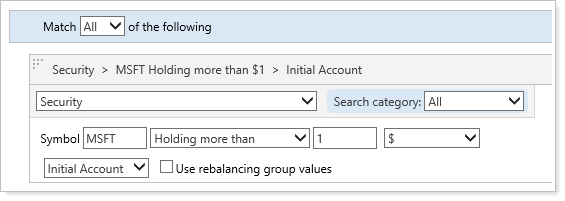 Back
Back
 Back Back |
Home > Tamarac Trading > Rebalances and Trades > Directed Trades > Identify Accounts for Directed Trades
|
Identify Accounts for Directed Trades
Directed trades allow you to focus on individual securities while giving you the option of trading across a group of accounts outside the constraints of a rebalance.
When creating a directed trade, the options you choose depend on your strategy, but the basic workflow is the same:

This page provides steps for how to identify accounts appropriate for directed trades. For information about other steps in the Directed Trades workflow, see Directed Trades Process.
For more information on specific strategies that can be used with directed trades, see Strategies Using Directed Trades and Directed Trades Versus Rebalancing.
Often, the first step in the directed trades process is identifying accounts in which you want to complete a directed trade. Use saved searches to identify and save a list of those accounts based on search criteria that you set.
For steps to create a saved search, see Create, Edit, or Delete Saved Searches. Once you create a saved search, you can also share that search with others or save the search to use in the future. You can then use the saved search to apply accounts to your directed trade.

Here are some useful saved searches you might use:
Accounts that contain a specific security; for example, all accounts with a position in AAPL
Accounts with a specific Allocation model that has recently been changed
Accounts containing a specific Security Level model
Accounts with a certain amount of excess cash
For more information on creating saved searches as well as examples of commonly used saved searches, see Working With Saved Searches.
Here are some example saved searches you can create before generating a directed trade:
Accounts using a specific Security Level model.The search below identifies accounts that are using the Large Cap Technology model.

Accounts using a specific Allocation model.The search below identifies accounts that are using the Moderate Growth 75/25 model.

Accounts containing a specific security.The search below identifies all accounts that contain MSFT.

There are many other options for saved search criteria which you can use to identify accounts needed in a directed trade. For more information on creating a saved search, see Learn More About Searching for Accounts.
Go to the next step, Create, Edit, or Delete Directed Trades.